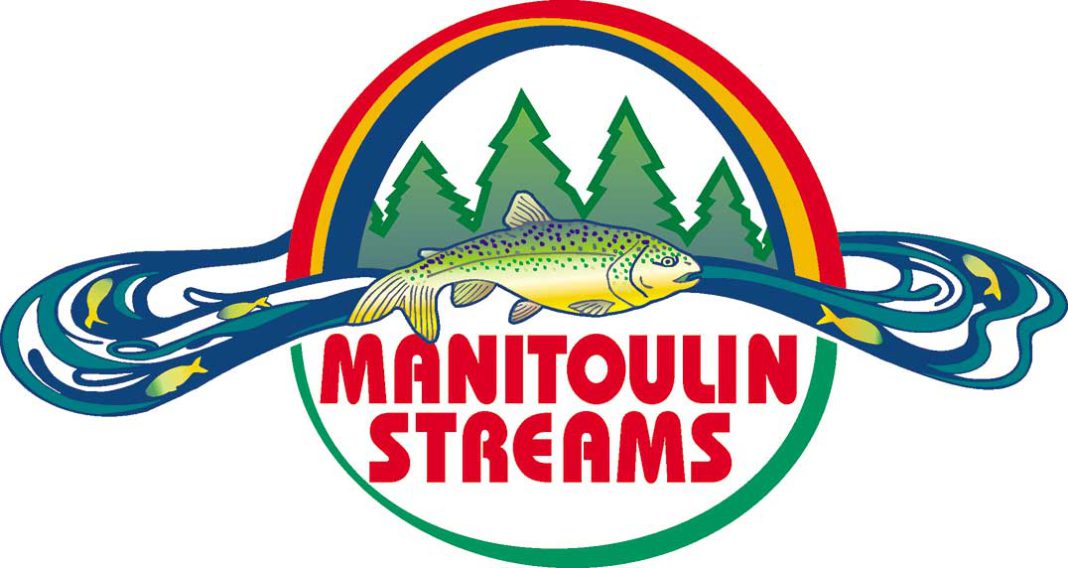SHEGUIANDAH—Manitoulin Streams, the Island’s award-winning stream rehabilitation organization, held its annual general meeting at the Sheguiandah Seniors’ Hall September 27.
Following the election of officers for 2018-2019, those attending the AGM received a synopsis of the important work being done by the Laurentian University Living Lakes program and the remarkable story of the recovery of the Aurora trout, the fish that had become the “poster child” of the battle to reduce acid rain yet was brought back from the brink of extinction through the dogged determination of a handful of dedicated scientists. Following Dr. Gunn’s presentation, Manitoulin Streams Executive Director Seija Deschenes, a former student at the Living with Lakes Centre, then delivered a breakdown of the work accomplished by Manitoulin Streams and its partners and volunteers over the past season.
There were four positions to be elected at the AGM, those of secretary, treasurer and two directors. The incumbents were acclaimed back into their slots, with Al Tribinivicius re-elected as secretary, Therese Trainer re-elected as treasurer, Neil Debassige and Delmer Fields re-elected as directors.
Dr. Gunn has spent the past 40 years working in the field to study the environmental impacts of human interaction and climate change on freshwater lakes and rivers. Both his synopsis of the work being done at the Living Lakes Centre and the remarkable tale of the amazing recovery of the Aurora trout brought a message of hope for those contemplating the challenge of carbon emissions and the human impact on climate change.
“We can learn a lot from what happened in Sudbury with sulphur dioxide,” said Dr. Gunn, who pointed out that over the period since the 1960s, there has been a reduction of 97 percent in pollutants in the air over that mining region.
In addition to the studies being conducted at the Living with Lakes Centre, the institution is also engaged in “producing the Seijas of the world,” noted Dr. Gunn. Since its inception, the centre has trained 300 students, with 80 onsite right now. The centre’s building is remarkable in its own right, explained Dr. Gunn. “Of the 5,000 rated buildings in the world, we are number three in North America,” he said. “One of my big jobs is to attract young minds to the centre.” Of another interesting note, Dr. Gunn pointed out that four of the five last scientists at the centre now, four are women. “That is a big change as well,” he said, noting that the field has long been dominated by men.
Sudbury has long been synonymous with pollution, so much so in fact that global scientists have long measured the industrial pollution in their regions in measurements of “Sudburys.”
Sudbury’s 2.5 million tons of pollutants a year exceeded that of the entire industrial output of Europe today.
Today, the famous Sudbury Superstack, long reigning as tallest of its kind in the world and once the world’s tallest freestanding structure has been decommissioned and is slated to be torn down. “That is not something I ever thought I would see in my lifetime,” said Dr. Gunn. Although there are those who want to see the stack remain a part of the Sudbury skyline, Dr. Gunn is not one of those fans. He noted that just to keep the stack from disintegrating it must be heated; to the tune of $500,000 a year.
The superstack was built to diffuse the pollution from nickel and copper refining operations over a wide area, as for many decades diffusion was the only viable technology to deal with its output. The black rocks of the Sudbury region were testament to the impact of mining and smelting on the landscape. Not as visible were the 7,000 lakes the pollution damaged. The advent of acid rain and the many lakes that were sterilized, their waters becoming crystal clear, yet barren of life, led to a determined effort to deal with the issue.
Enter the story of the Aurora trout. “It is a story that every Canadian should be proud of,” said Dr. Gunn. The Aurora trout was known as the “Northern Lights” fish. “It could be found in only two lakes in the world, but it started to disappear in the 1950s.”
For decades, American anglers would pay enormous sums to travel to those two remote lakes near Cobalt to pursue the fabled fish, a type of brook trout with a distinctive red colouration that gave the fish its name. But by the mid-1950s those anglers were voicing their displeasure at having laid out huge amounts of money only to go home empty handed. The fish were disappearing rapidly.
A ministry scientist travelled to the lakes and collected a number of the Aurora trout to study.
“Two years later he went back and there were no fish left in the lakes,” said Dr. Gunn. The only remaining Aurora trout were living in captivity in a ministry fish hatchery. Despite the best efforts to find a new home in which to introduce the trout, over the next 40 years the only reproducing fish were to be found in the hatchery. Although the Aurora trout might survive a couple of years, naturally reproducing in the lakes into which they were stocked, in every case they eventually died out. Worse, an accident at the hatchery resulted in most of the captive fish dying as well. At one point there were only 10 fish left.
“The media found out about the trout and they soon became a rallying cry for the acid rain debate,” said Dr. Gunn. That uproar became a major public relations black eye for INCO Ltd., the company that owned the Superstack. “They didn’t like the story,” said Dr. Gunn.
Another hit came in 1989 when the ministry decided saving the Aurora trout was a lost cause and no longer worth it to try and save. But the hatchery manager remained resolute.
Eventually the decision was made to attempt to reintroduce the fish back into the lakes from which the fish originally hailed. The lakes had slowly recovered to the point that it might be possible to sustain a population.
“What happened then almost became a fiasco,” said Dr. Gunn. The notoriety the Aurora trout had garnered as the poster child of acid rain almost led to total disaster.
It seems at the 11th hour the then-provincial minister decided that he wanted to be the one who “saved” the Aurora trout. He would fly to the lakes to meet the scientist and release the trout into the lakes. The world’s media also caught wind of the release and teams of newshounds from the CBC, the Globe and Mail and even the UK’s Guardian newspaper were descending on the lakes. Only there was a bit of a problem.
“The pilot informed me that he would not be able to land on the lake,” recalled Dr. Gunn. The two lakes were relatively tiny, Whitepine was a mere 11 hectares and Whirlygig a still-minute 77 hectares. Whirlygig was packed with the planes of the minister and the media entourage. “We had no place to land.” Meanwhile, the fish in the tanks were beginning to stress. Soon there would be nothing but dead bodies floating on the top of the tanks.
The team managed to land on the waters of an adjacent lake. With time fast running out, Dr. Gunn struck a deal with the various cameramen who were by then standing around the floatplane and its tanks.
“Cameramen are very strong,” he said. “I guess it comes from toting those old big cameras around all day.”
The deal worked like this. The cameramen would form a bucket brigade up and across the intervening hill, portaging buckets of fish to the safety of the waters in the target lakes. In return, the scientists would hold back one fish in a pen. Each news organization (and the minister) would get an opportunity to film the “release of the first fish” with their very own exclusive.
The cameramen agreed, the fish were hauled up and across the mountain and released into the wild. Then the “exclusive” filming took place and each crew returned to their respective news offices bearing the scoop of the century. The operation was hauled back from the brink of disaster to become the environmental success story of the 20th Century. The Aurora trout began to reproduce naturally and, from those 10 lonely fry that survived the earlier hatchery disaster, the population recovered and thrived.
The two lakes are still somewhat acidic, after core sample studies were conducted to look at the lakes’ historical composition, it turns out they have a natural acidity that is higher than what was originally believed to be the natural balance. “Turns out the lakes were always at around 5.2 points of acidification,” said Dr. Gunn.
Those two lakes remain teeming with Aurora trout to this day, protected from angling.
Dr. Gunn recently had the honour of being the only one allowed to fish the lakes, as he had the job of hauling one in every 20 minutes for a blood study being conducted by a Norwegian science team.
Now a new threat is arising. Because of the earlier acidification of the lakes, the amount of calcium present has been leeched out of the underlying rocks. As a result, the lakes hover close to the line on which the trout can survive. But as of this moment, the water has not crossed over that line.
The Aurora trout are no longer listed as “endangered.”
On an interesting side note, the home lakes of the Aurora trout are paired with a similar lake in Scotland—the royal lake Balmoral. That lake, it turns out, holds the dubious honour of having the heaviest concentration of industrial pollutants in Europe.
Dr. Gunn applauded the work of Manitoulin Streams and groups like the Little Current Fish and Game Club in both the rehabilitation of local habitat and the education of young students about the importance of conservation—but most importantly in encouraging children to get out fishing.
Manitoulin Streams has a definitely positive impact on the Manitouling economy. Its revenue of $293,207 employed three full-time staff, one community resource stewardship liaison through Canada Summer Jobs, one invasive species awareness liaison through the Ontario Federation of Hunters and Anglers and one person on a contract position. Since 2003, the organization has provided a direct economic stimulus of over $5 million—not to mention the ancillary impact of the tourists drawn to the region because of their work.
Since its inception Manitoulin Streams has repaired 122,981 square metres of aquatic habitat, enhanced 350,557 square metres of riparian habitat, planted 53,159 trees, installed more than five kilometres of fencing, numerous cattle nose pumps, watering ramps and stocked a whopping 60,000 brook trout eggs.
Projects in 2018 have seen almost 700 shrubs planted along the shores of the Kagawong River, 11 root wads planted, 200 trees planted with the students of CC McLean, 850 square metres of seed mix and 450 square metres of coir mat applied to stabilize its shores. Some 1.3 kilometres of shoreline have been cleared of garbage, log jams removed to correct water flow and tons of river stone strategically placed to enhance fish habitat and prevent erosion.
In addition, Manitoulin Streams has been active in partnering with work in Wiikwemkoong, the Northeast Town, Central Manitoulin, M’Chigeeng and Tehkummah, working through the oppressive heat of removing phragmites and other invasive species from Manitoulin’s shores.




